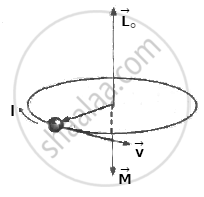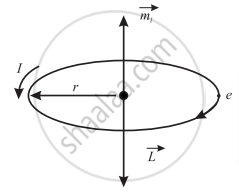Advertisements
Advertisements
Question
Obtain an expression for the orbital magnetic moment of an electron rotating about the nucleus in an atom.
Solution 1
In the Bohr model of a hydrogen atom, the electron of charge - e performs a uniform circular motion around the positively charged nucleus. Let r, v and T be the orbital radius, speed and period of motion of the electron. Then,
T = `(2pi"r")/"v"` ...(1)
Therefore, the orbital magnetic moment associated with this orbital current loop has a magnitude,
I = `"e"/"T" = "ev"/(2pi"r")` ...(2)
Therefore, the magnetic dipole moment associated with this electronic current loop has a magnitude
M0 = current × area of the loop
`= "l"(pi"r"^2) = "ev"/(2pi"r") xx pi"r"^2 = 1/2 "evr"` ....(3)
Multiplying and dividing the right-hand side of the above expression by the electron mass me,
`"M"_0 = "e"/(2"m"_"e") ("m"_"e""vr") = "e"/(2"m"_"e") "L"_0` ....(4)
where L0 - mevr is the magnitude of the orbital angular momentum of the electron. `vec"M"_0` is opposite to `vec"L"_0`.
∴ `vec"M"_0 = - "e"/(2"m"_"e") vec"L"_0` ....(5)
which is the required expression. →

According to Bohr's second postulate of stationary orbits in his theory of hydrogen atom, the angular momentum of the electron in the nth stationary orbit is equal to n `"h"/(2pi)`, where h is the Planck constant and n is a positive integer. Thus, for an orbital electron,
`"L"_0 = "m"_"e" "vr" = ("nh")/(2pi)` ...(6)
Substituting for L0 in Eq. (4),
`"M"_0 = "enh"/(4pi"m"_"e")`
For n = 1, M0 = `"eh"/(4pi"m"_"e")`
The quantity `"eh"/(4pi"m"_"e")` is a fundamental constant called the Bohr magneton,
`therefore mu_"B" * mu_"B"`
`= 9.274 xx 10^-24 "J"//"T"` (or Am2)
= 5.788 x 10-5 eV/T.
Solution 2
Expression for magnetic dipole moment:
- Consider an electron of mass me and charge e revolving in a circular orbit of radius r around the positive nucleus in a clockwise direction, leading to an anticlockwise current.

U.C.M of an electron around the nucleus - If the electron travels a distance 2πr in time T then, its orbital speed v = 2πr/T
- The magnitude of circulating current is given by,
I = e`(1/"T")`
But, T = `(2pi"r")/"v"`
∴ I = e`(1/(2pir"/""v")) = "ev"/(2pi"r")` - The orbital magnetic moment associated with the orbital current loop is given by,
morb = IA = `"ev"/(2pi"r") xx pi"r"^2` [∵ Area of current loop, A = πr2]
∴ morb = `"evr"/2` ….(1) - The angular momentum of an electron due to its orbital motion is given by,
L = mevr - Multiplying and dividing the R.H.S of equation (1) by me,
morb = `"e"/(2"m"_"e") xx "m"_"e""vr"`
∴ morb = `"eL"/(2"m"_"e")` - This equation shows that the orbital magnetic moment is proportional to the angular momentum. But as the electron bears a negative charge, the orbital magnetic moment and orbital angular momentum are in opposite directions and perpendicular to the plane of the orbit.
Using vector notation, `vec"m"_"orb" = -("e"/(2"m"_"e"))vec"L"`
Solution 3
Consider an electron moving with constant speed v in a circular orbit of radius r about the nucleus as shown in the figure.

If the electron travels a distance of 2πr (circumference) in time T, then its orbital speed, `v=(2pir)/T`.
Thus the current I associated with this orbiting electron of charge e is
`I = e/T`
`T = (2pi)/omega and omega=v/r`, the angular speed
`I = (eomega)/(2pi)=(ev)/(2pir)`
The orbital magnetic moment associated with orbital current loop is
`m_("orb")=IA=(ev)/(2pir)xxpir^2`
`=1/2evr`
APPEARS IN
RELATED QUESTIONS
An electron in an atom is revolving around the nucleus in a circular orbit of a radius of 5.3 x 10-11 m, with a speed of 2 x 106 m/s. Find the resultant orbital magnetic moment and angular momentum of the electron. [e = 1.6 x 10-19 C, me= 9.1 x 10-31 kg]
What is stated in terms of Bohr magneton?
The electron in the hydrogen atom is moving with a speed of 2.5 × 106 m/s in an orbit of a radius of 0.5 Å. What is the Magnetic moment of the revolving electron?
Explain the origin of magnetism in material, hence find a magnetic moment of an electron revolving around the nucleus of an atom.
The magnetic moment of electrons due to orbital motion is proportional to ______.
(n = principal quantum numbers)
The S.I. unit of gyromagnetic ratio is ______
The angle made by orbital angular momentum of electron with the direction of the orbital magnetic moment is ______.
Dimensions of Gyromagnetic ratio are _________.
An electron revolving in a circular orbit of radius 'r' with velocity 'v' and frequency v has orbital magnetic moment 'M'. If the frequency of revolution is tripled then the new magnetic moment will be ____________.
In a hydrogen atom, an electron of charge e revolves in a orbit of radius r with speed v. Then, the magnetic moment associated with electron is ______.
Which one of the following proportionality represents the relation between orbital magnetic moment M0 and orbital angular momentum L0 of an electron?
An electron revolving in a circular orbit of radius 'r' with velocity 'V' and frequency 'v' has orbital magnetic moment 'M'. If the frequency of revolution is doubled then the new magnetic moment will be ____________.
An electron of charge 'e' is revolving in a fixed orbit of radius 'r' with frequency 'f'. Its magnetic dipole moment is ____________.
Magnetic moment of revolving electron of charge 'e' and mass 'm' in terms of angular momentum 'L' of electron is ____________.
An electron in the ground state of hydrogen atom is revolving in a circular orbit of radius R. The orbital magnetic moment of the electron is ____________. (m = mass of electron, h = Planck's constant, e = electronic charge)
The period of oscillation of a magnet in a vibration magnetometer is 2 sec. The period of oscillation of a magnet whose magnetic moment is four times that of the first magnet is ______.
Which of the following expression represents the relation between orbital magnetic moment and orbital angular momentum of an electron?
A bar magnet of magnetic moment M1 is cut into two pieces along its axis. The pieces are kept perpendicular to each other with their unlike poles in contact. The magnetic moment of the arrangement is M2. The ratio of M1/M2 is ______.
An electron in an atom is revolving around the nucleus in a circular orbit of radius 0.53 A, with a speed of 2 x 106 m/s. Find the resultant orbital magnetic moment and angular momentum of electron.(e = 1.6 x 10-19 C, m = 9.1 x 10-31 kg)
The electron in the hydrogen atom is moving with a speed at 2.3 x 106 m/s in an orbit of radius 0.53Å. Calculate the magnetic moment of the revolving electron.
